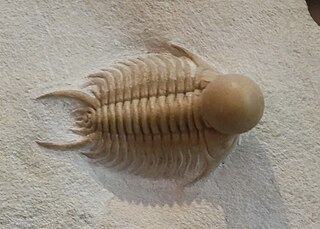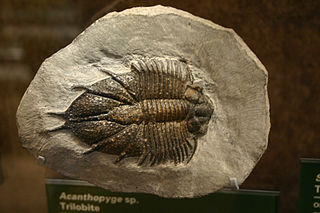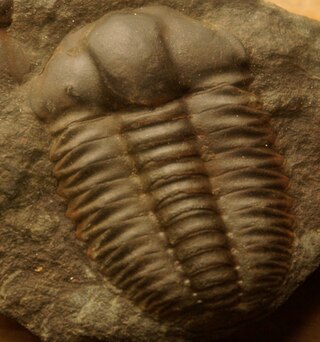
Trilobites are extinct marine arthropods that form the class Trilobita. Trilobites form one of the earliest known groups of arthropods. The first appearance of trilobites in the fossil record defines the base of the Atdabanian stage of the Early Cambrian period and they flourished throughout the lower Paleozoic before slipping into a long decline, when, during the Devonian, all trilobite orders except the Proetida died out. The last trilobites disappeared in the mass extinction at the end of the Permian about 251.9 million years ago. Trilobites were among the most successful of all early animals, existing in oceans for almost 270 million years, with over 22,000 species having been described.

The pygidium is the posterior body part or shield of crustaceans and some other arthropods, such as insects and the extinct trilobites. In groups other than insects, it contains the anus and, in females, the ovipositor. It is composed of fused body segments, sometimes with a tail, and separated from thoracic segments by an articulation.

Ptychopariida is a large, heterogeneous order of trilobite containing some of the most primitive species known. The earliest species occurred in the second half of the Lower Cambrian, and the last species did not survive the Ordovician–Silurian extinction event.

Proetida is an order of trilobite that lived from the Ordovician to the Permian. It was the last order of trilobite to go extinct, finally dying out in the Permian-Triassic extinction event.
The Lopingian is the uppermost series/last epoch of the Permian. It is the last epoch of the Paleozoic. The Lopingian was preceded by the Guadalupian and followed by the Early Triassic.

Encrinurus is a long-lived genus of phacopid trilobites that lived in what are now Africa, Asia, Australia, Europe, North America, and South America from the middle Ordovician to the early Devonian from 472 to 412.3 mya, existing for approximately 59.7 million years.

Sphaerocoryphe is a genus of trilobite that lived from the middle Ordovician to the Silurian. Its fossils have been found in Australia, Europe, and North America. Both Sphaerocoryphe and Hemisphaerocoryphe had a characteristically bulbous glabella, and the two may represent only one genus.

Cheirurus is a genus of phacopid trilobites that lived from the Ordovician to the Devonian. Its remains have been found in Africa, Asia, Australia, Europe, and North America. Cheirurus is the type genus of Cheiruridae.
Acastava is an extinct genus of trilobite in the order Phacopida, from the upper Pragian to Emsian period of the Devonian.

Aulacopleura is a genus of proetid trilobite that lived from the Middle Ordovician to the Middle Devonian. Some authors may classify this group as subgenus Otarion (Aulacopleura). The cephalon is semicircular or semielliptical, with border and preglabellar field. The glabella is short, with or without defined eye ridges connecting it with eyes of variable size. Spines at the rear outer corners of the cephalon are present, typically reaching back to the 2nd to 4th thorax segment. The 'palate' is not connected to the dorsal shield of the cephalon. The cephalon is pitted, or has small tubercles. The thorax has up to 22 segments. The pleural ends are usually rounded. The pygidium is small (micropygous), with an even margin. A. koninckii had a modern type of compound eye.

Changaspis is an extinct genus of trilobite that lived during the lower Cambrian in what is now China.

Ogyginus is an extinct genus of asaphid trilobites that lived during the Ordovician period. Commonly found in Wales. The type specimen was first described by Murchison in 1839 as Asaphus corndensis, though the species was later reassigned.

Acanthopyge is an extinct genus of lichid trilobite that lived during the Devonian. Very few A. consanguinea from the Devonian of Oklahoma have been found, and only a handful of complete specimens from Morocco, and many so-called Acanthopyge-specimens from Morocco are fake.

Ellipsocephalus Zenker, 1833, is a genus of blind Cambrian trilobite, comprising benthic species inhabiting deep, poorly lit or aphotic habitats. E. hoffi is a common trilobite mainly from central Europe.

Harpides is an extinct genus of harpetid trilobite of the family Harpididae.
Szechuanella is an extinct genus of corynexochid trilobite that lived marine environments from the middle Cambrian to the early Ordovician in what is now China.

Phillipsiidae is a family of proetid trilobites, the various genera of which comprise some of the last of the trilobites, with a range that extended from the Kinderhookian epoch of the Lower Mississippian, to the end of Changhsingian age at Permian-Triassic extinction event in the latest Permian period.

Olenina is an extinct suborder of the trilobite order Ptychopariida.
Pseudophillipsia is a genus of trilobite, notable for being one of the last members of the group before the extinction at the end of the Permian. It first appeared during the Pennsylvanian or Late Carboniferous. There are several species and this genus has a range spanning Eurasia.

Lioharpes is a genus of trilobites in the order Harpetida. The genus Eskoharpes possibly evolved from it. It is synonymous with Fritchapsis.















